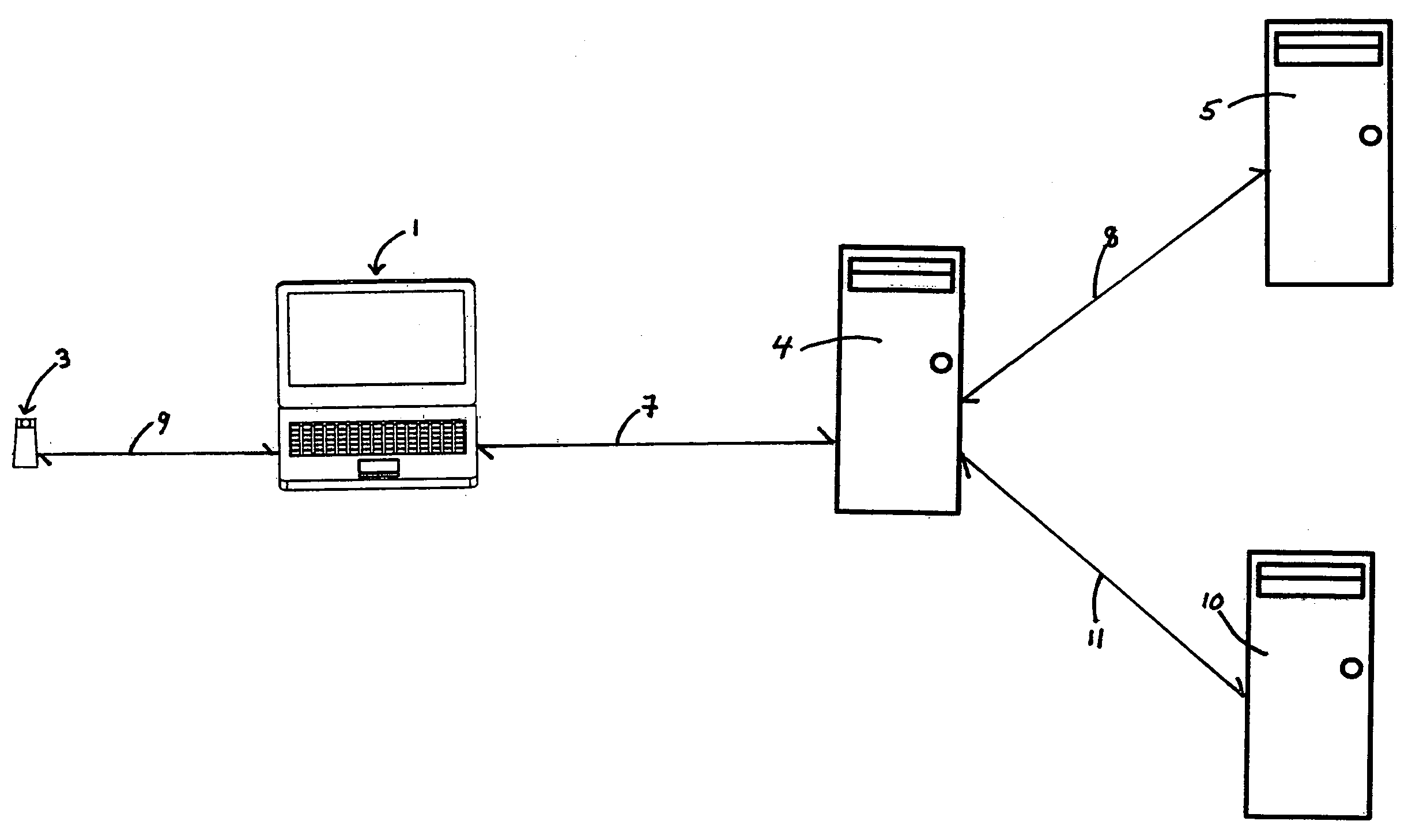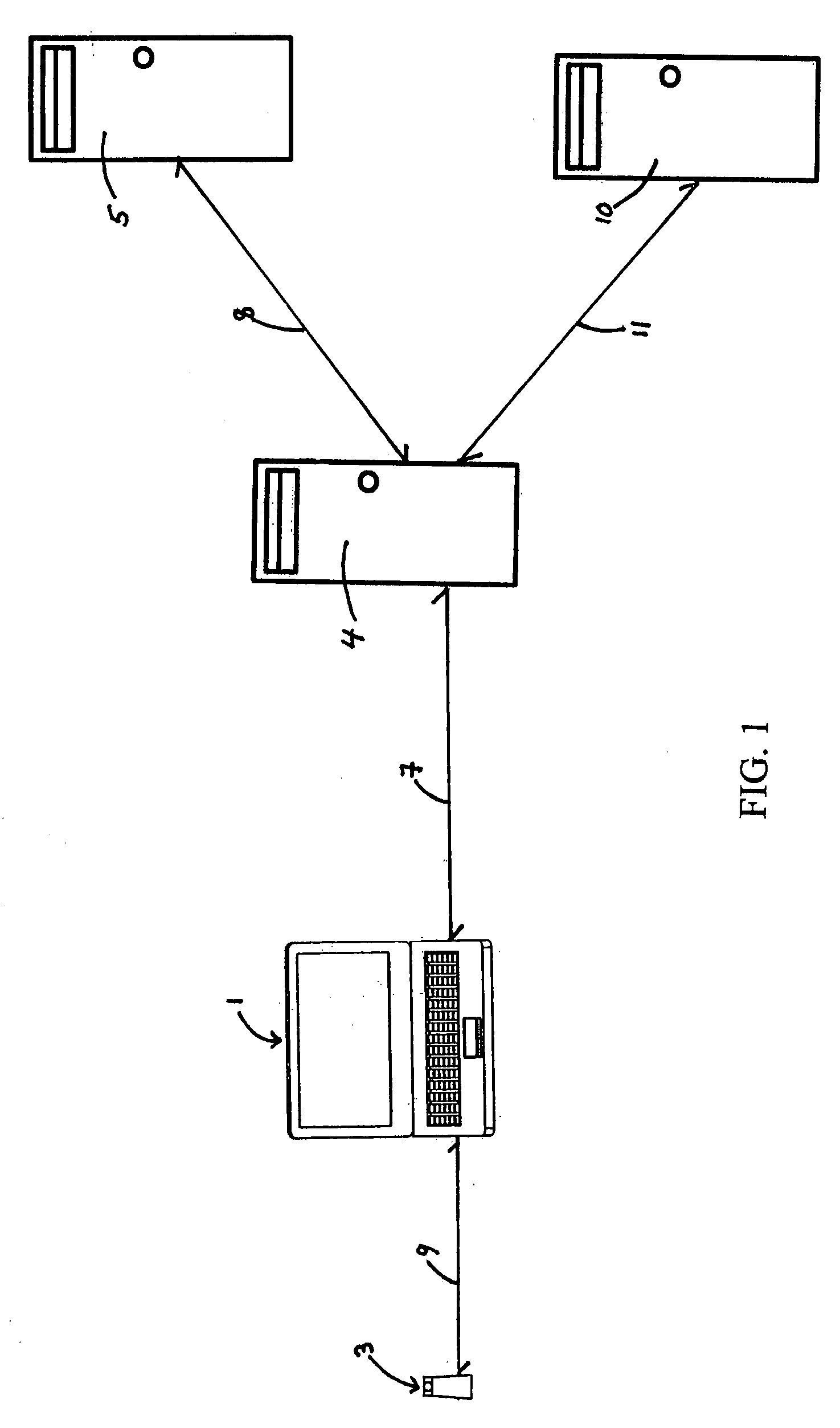[0007]The term “communication” as used throughout this specification and its appended claims is intended to be broadly construed, and is intended to refer to hard-
wired communication, as well as electromagnetic (such as radiofrequency or
microwave), optical, or
fiber optic communication. The term “
communication link” as used throughout this specification and its appended claims is intended to be broadly construed, and is intended to refer to hard-wired or
wireless communications connections between a computer,
computer hardware, or peripherals, or may refer to the hard-wired,
wireless, networked, or internet connected communication links between a plurality of computers, including the enrollee computer (1), or the equivalent such as a
library computer, and the school computer (4), or the equivalent such as a
data bank, remote website,
web server or
web server farm. Some communications links (7-9 and 11) referred to in the specification and its appended claims may be both hard-wired and
wireless, along the communications link. The communications links (7-9 and 11) shown in the drawing figures are intended to reflect the flow of information in said links. The shown links (7-9 and 11) therefore show a half-arrowhead in each of the two directions, with the primary direction of information flow being shown with the half-arrowhead on the top right part of the link shown, and indicating information generally flowing to the right side of the drawing figure. See: FIGS. 1-9, thereto. If there is a secondary or minor information flow, it is typically in the opposite direction, and shown with a half-arrowhead to the left, and shown on the left side of the link. See: FIGS. 1-9. The communications links (7-9, and 11) shown in the drawing figures, FIGS. 1-9, are not drawn to scale, and may be many miles, or many thousands of miles in length, which is a major
advantage of the present invention, allowing education services over great distances.
[0008]The term “fingerprint” as used throughout this specification and its appended claims is intended to be broadly construed, and is also intended to refer to a thumbprint, or even a
toe print, and may include a partial fingerprint or the like, assuming it passes the security requirements of the Fingerprint
Verification System.
[0009]The term “fingerprint verification device” (3) as used throughout this specification and its appended claims is intended to be broadly construed, and is intended to refer to both independent fingerprint devices (3) in communication with the enrollee's computer (1), as well as fingerprint verification devices (3) that may be incorporated into the enrollee computer (1) housing or the enrollee's
computer monitor, keyboard, mouse,
laptop memory card, camera device, or other
peripheral devices.
[0010]The term “random” as used throughout this specification and its appended claims is intended to be broadly construed, and is intended to also refer to pseudorandom or seemingly random, which are also intended to be broadly construed. A so-called “random” or “pseudorandom” or “seemingly random” sequence of numbers under this definition may not be a normal number, in the strict number theoretic sense, but would be as close as the
system designer desires to such number theoretic normality. Said sequence'
s distribution of digits would not follow Benford's Law, as this would indicate a significant deviation from randomicity or pseudorandomicity. Such randomicity, pseudorandomicity, or seeming randomicity may be generated, for purposes of this Fingerprint
Verification System, by using non-random numbers manipulated to appear random or pseudorandom. For example, one might use a sequence of prime numbers or a recurrence of said prime number sequence, that might include one or more twin primes, and such numbers may represent minutes into the course where the fingerprint device (3) is activated to require a fingerprint verification. A
random number table, such as the RAND Table of Random Numbers, may also be used in a similar manner. Data logs and the like, of random radioactive emissions are available and may also serve as a random
number generator.FIELD OF THE INVENTION
[0011]As noted above, this Fingerprint Verification for Computerized Course Attendance and Performance Testing relates to a new, useful and significant means and method of verifying the identity of a computerized or computer-based course attendee, and said attendee's attendance throughout the computer-based course, and the attendee's identity during test taking throughout the course. Such a computer-based course may be online or off-line, but in both sets of embodiments, fingerprint identification of the attendee is required, and at times specifically designed to reliably verify the identity of the attendee, and to overcome counter-measures an attendee may attempt to enter a false positive fingerprint identification. In short, one might think of the Fingerprint
Verification System as a new, useful, and significant means of assuring a school or the like, and the government if they are an interested party, that the identity of an attendee and examinee for a computerized course is the same as the identity of the course's enrollee, and that the enrollee is in attendance throughout much of the computerized course.DESCRIPTION OF THE RELATED ART INCLUDING INFORMATION DISCLOSED UNDER 37 CFR 1.97 AND 1.98
[0012]Many industries and aspects of everyday living are changing with the advent of personal computers,
laptop computers, and data communications. The present Fingerprint Verification invention was conceived, devised, invented, and engineered to make education and required and elective courses more accessible to those with access to a computer and to those with online access, and to make enrollment, attendance monitoring, and enrollee and examinee identity more reliable and without requiring significant
computer hardware or
software installation, or significant
time delays.
 Login to View More
Login to View More  Login to View More
Login to View More 


